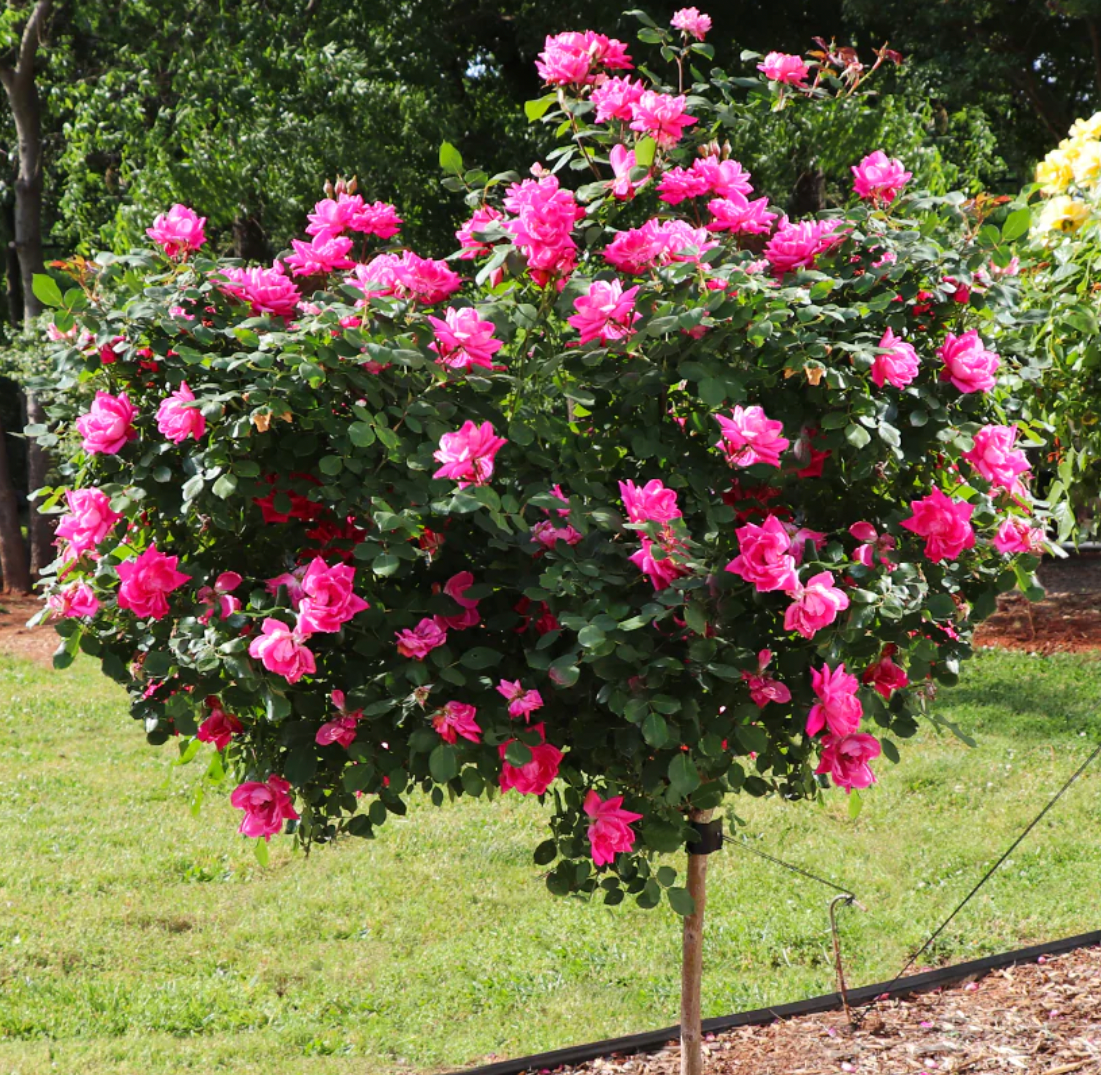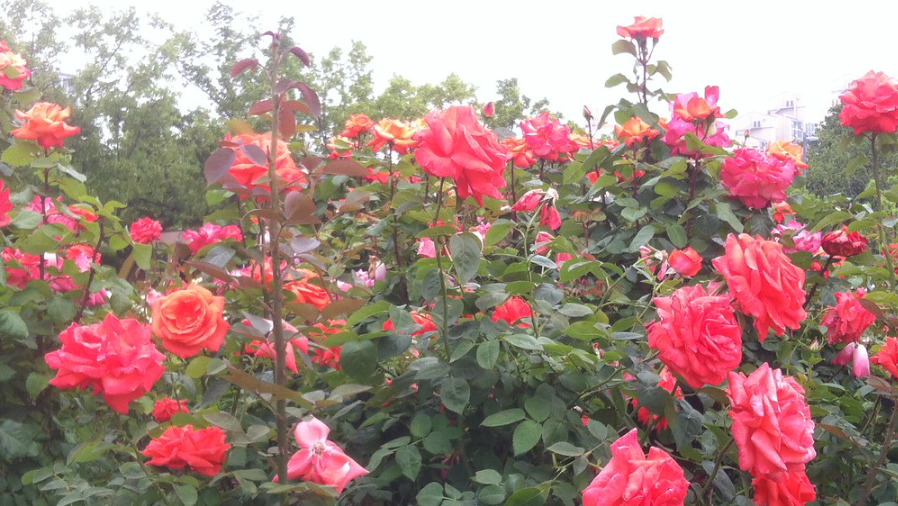Rose Tree Care

Not many people know what goes into Rose Tree Care. Just like every other tree or plant, it takes a lot of work. We'll go everything you need to know below.
Fast Facts for Rose Trees
| Common Name | Rose |
|---|---|
| Scientific Name | Rosa rubiginosa |
| Month(s) of Harvest | First bloom cycle typically starts after the last winter frost, allowing harvesting every 6 to 8 weeks from then till the end of the season |
| Light | Requires at least four hours of daily direct sunlight but can perform well against a north wall if they are in an airy and light aspect |
| Water | Established plants need to be watered every 2 to 3 days, while newly planted roses require daily watering |
| Soil | Need moisture-retentive soil with good drainage and a pH of 6.5 to 7 |
| Fertilizer | Established roses need a high-nitrogen fertilizer in the first application for leaf development, with Epsom salt application for lush growth and cane development. Meanwhile, a slow-release fertilizer should be applied when the shoots reach 4 to 5 inches in height. |
| Pests | Susceptible to leafcutting bees, scale insects, spider mites, aphids, and caterpillar attack |
| Diseases | Common rose diseases include downy mildew, black spot, powdery mildew, crown gall, and rust. |
| Growing Zone | Zones 5, 6, 7, and 8 |
Table of Contents

Get Your Own Rose Tree Here.
How To Take Care of Rose Trees
Growing rosebush trees is much easier than many other species. Here's what you need to know about rose trees care.
Soil & Container
Since rose trees are highly adaptable, they can grow in most soil types as long as they are deep, rich in organic matter, and well-drained. But the best soil for roses is loamy with a potential for moisture retention.
First, you need to make sure the soil is well-drained. To do that, dig a hole in your native soil, fill it with water, and see how long it takes to drain. If it takes more than an hour, your soil has a drainage problem.
You can either choose a different soil or improve your native soil's drainage. For the latter, add organic matter to the soil or break it up.
Grow your rose tree in a 12-inch clay, ceramic, or terracotta pot. Ceramic and terracotta are better than plastic and metal pots since they do not heat up much in the summer.
Water Requirements
The watering requirements for roses differ throughout the year, depending on the area's rainfall. Water at the base of the plant so that it keeps taking up water slowly.
- March to May: Water every 2 to 3 days if your roses are established. But if they are newly planted, water them daily.
- October to February: You won't necessarily need to water your plant during this period. But it will depend on the amount of rainfall your area gets. If the weather is extremely dry, do the same as you would from March to May.
- June to September: Water the roses every day when they're newly planted. For established plants, water every 2 to 3 days. When the roses bloom, check if they are wilting. If the plant wilts, you need to water it more since it's dehydrated.
Fertilizing and Filling
The organic amendments needed by new and established roses are different. Here's how to fertilize roses.
Newly Planted Roses
- Dig a planting hole.
- Fill it with a slow-release fertilizer following the manufacturer's instructions on the packaging.
- Add some bone meal to the mix, as it helps in root development.
- Sprinkle half a cup of Epsom salts at the base of the plant for cane development.
Fertilize rose plants every month with a mild fertilizer. Fish emulsion is a good option in this case. If your new rose bush dries out, do not add full-strength fertilizers since they can cause burns on the root tips and leaf margins.
Established Roses
In early spring, add a high-nitrogen fertilizer to the plant to start leaf development. Also, sprinkle some Epsom salts. When the shoots grow tall, apply a slow-release fertilizer.
Continue fertilizing the plant every four weeks in the growing season. When fall arrives, put a slow-release fertilizer, such as bone meal, that has a low nitrogen content.
Do not fertilize rose plants 6 to 8 weeks before the first winter frost to prevent frost damage to new growth. Established rose trees are one of the best-looking front yard trees. Your neighbors will be jealous of these beauties out front.
Sun & Placement
Roses love direct sunlight. At a minimum, they should get four hours of direct daylight. Plant your roses in a spot that gets full sun and allows plenty of room for air circulation.
Temperature and Humidity
The ideal temperature for rose plants is 60 and 70 degrees Fahrenheit. High temperatures affect roses adversely, with temperatures over 85 degrees causing leaf scorch.
As for humidity, it should be between 60-70%. Roses usually prefer warm climates but can live in a range of environments. They can withstand temperatures below 10 degrees F, but not for long. You should bring your roses inside if the temperature stays under 20 degrees F for too long.
Pruning
The right time to prune roses is in early spring or late winter. Depending on your region, this could be in late May or early January. Follow this routine based on the zone you're growing roses in:
- Zones 3 and 4 - May
- Zones 5, 6, and 7 - March or April
- Zone 8 - February or March
- Zone 9 - January or February
- Zone 10 - January
Start by removing the remaining leaves of the plant. Then, cut dead wood, which will be brown in color. Remove weak and tiny growth.
Then, prune the branches about 1/2 to 1/4 inch above the bud eye (outer-facing bump where the stem and leaf would meet). Doing this will encourage new steps to grow outward.
After pruning, remove all the cut branches and leaves from the area and dispose of them so that no pests remain close to healthy trees. Sterilize your pruning tools, such as shears, with isopropyl alcohol, between cutting.
Did You Know? Some of the rose fossils found by archaeologists date back 35 million years, and the oldest living rose is nearly 1,000 years old.

Credit: Flickr
Rose Tree Problems
Growing your own rose garden seems like the ultimate dream until you realize the difficulties and diseases that can affect rose trees. Some of the most common issues are discussed below.
Not Flowering
Modern rose cultivars bloom throughout the season from May to October if the climate allows. If your plants are not blooming, they're likely not getting sufficient sunlight. Make sure you keep the pots in an area with over four hours of direct sunlight.
Also, do not over-fertilize rose plants since this can cause the plants to become leafy and delay flowering.
Black Leaf Spots
Black Spot is a common fungal disease of the rose plant identified as the appearance of black and circular spots on rose leaves. Over time, the leaves turn yellow and then eventually fall off the branch.
The key to management is to prune the infected canes before spring so that they do not impact nearby leaves and flowers. Also, rake the leaves that fall on the floor.
Alternatively, you can grow varieties resistant to blackspot:
- Hybrid tea: Pride N Joy
- Floribunda: Sexy Rexy
- Grandiflora: Prima Donna
Curling Leaves
Another fungal disease that affects rose trees is powdery mildew. It is characterized by curling leaves with a purple coloration. With the progress of the disease, powdery fuzz forms on the leaves.
The main difference between blackspot and powdery mildew is that the former affects the underside of the leaves, while the latter is evident on the top.
You should apply fungicide to new growth to prevent fungal attacks. Also, make sure you grow roses in an area with good circulation so that the leaves dry quickly and don't become a breeding ground for fungi.
The following varieties are resistant to powdery mildew and black spot:
- Rugosa roses: Blanc Double de Coubert and Fru Dagmar Hastrup
- Alba rose: Alba Semi-Plena
Orange Leaf Spots
The Phragmidium fungi are responsible for causing rust, which results in orange dust-like spots on rose leaves. Rust attacks all parts of the rose plant except its petals and roots. Here's how to avoid this condition:
- Do not plant your shrubs in a crowded place.
- Water roses before noon, and do not wet the leaves.
- Remove diseased leaves.
Although fungicides do not do much once the disease has spread, they can prevent infection. Use fertilizers containing mancozeb or chlorothalonil to prevent rust.
Learning About Rose Trees
Although there are many types of roses, you can divide them into three categories:
- Modern Roses
- Wild Roses
- Old Garden Roses
Old Garden roses or antique roses have been grown since 1867. They have a strong fragrance but only flower once every season.
Wild roses are also called species roses since they have not been hybridized or cross-bred. Wild roses bloom once per season and have five-petal flowers. Most wild roses are pink.
Meanwhile, modern roses are a result of extensive breeding. They bloom throughout the season and have a long vase life. However, they lack the fragrance of old garden roses and are less disease-resistant.
Rose Tree Origin Story
According to fossil records, roses are some of the most ancient flowers worldwide. They originated in Central Asia but have since spread all across the northern hemisphere. Today, the rose family has over 90 genera and 2,500 species.
Sweet New Earth's Final Word On Rose Trees
Since there are so many rose varieties, from climbing roses to shrub rose, you're spoilt for choice when it comes to choosing the best cultivar for your garden. They can be planted directly into the soil or brought indoors in pots.
However, note that roses have major pruning needs throughout the year. We recommend growing roses in areas with a warm summer rather than cold climates. With the rose tree care tips mentioned in this guide, you'll have a homemade bouquet for your next anniversary.
Or you can eat roses. Their petals are edible, and you can also make rose water by soaking the petals in water. Add rose water to jams and jellies for additional flavoring.

Christina Hernandez
Christina has done most of her research on environmental science but recently has changed her focus towards sustainable forestry. She has a passion for the outdoors and wants to spread that passion to the world.
Join our community!
Join to receive guides, insights, and the latest gardening deals!
